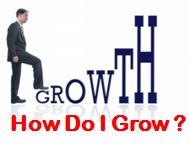Startup to Growth Stage

A successful transition from Startup to Growth Stage requires certain actions to be followed.Any startup’s priority is to acquire customers and gain traction. Many a times, acquiring initial customers is easy, based on the entrepreneur’s network. With the proof of concept in hand, the next step to rapidly acquire customers throws up mSore challenges.
The challenges faced in growth stage are completely different from those at the start of a business.

Image Source: arztsamui
Startup to Growth Stage- Expert Opnion
Mohan Sawhney- Professor at North Western’s Kellogg School of Management
"The organic nature of early-stage growth can often leave companies relying on a handful of talented leaders to handle everything from acquiring new clients to managing functions in an informal, reactive way. Once a company achieves a certain size, the needs of the business typically overwhelm these ad hoc approaches."
Startup to Growth Stage- Challenges
The following are the challenges faced by any startup when they move to growth phase.
1. Ad hoc, not process driven approaches are deterrent to growth.
2. Slow response to changes in Product -Market fit as competition heats up.
3. Bootstrapped companies lack resources to capture market opportunity
4. Lack of Continuous Scanning of Environment
5. Slow reaction to emerging external threats
6. Short to medium term focus
7. Solopreneurs inability to attract talent
8. Abrupt departure of Critical Resources
9. No entry barriers built
10.Lack of networking skills
11.Emotions overtaking rationale in hiring and firing
12.Induction of VC fund at an early stage before consolidation
13.Change of mindset from being a Corporate Executive to an Entrepreneur has not happened
14.Lack of social media marketing
15.Lack of sound business model which results in failure after initial launch
16.Sharing of tasks by founding team in the initial stages should develop into delegating in growth
17.Top Management not moving to strategic roles and focusing only on day to day operations
18.Cash Flow crisis where cash burnout higher than cash accruals
19.Extending long credit periods to achieve topline growth and thereby increasing risk of bad debts
Startup to Growth Stage- Observations of Starting Up
Choozle-MEGAN SULLIVAN-JENKS
CELEBRATE WINS – BIG AND SMALL
Even in the beginnings of a company, it’s important that you recognize the small wins. As your company is growing, there can be long lulls between the pivotal moments of triumph. If you want to contribute positively to company morale, it’s important to have a way to recognize small wins along the way. This means during daily or weekly huddles, you need to recognize and talk about the small achievements with your team. Simple, verbal recognition is a great reward and helps keep the team momentum.
ACCEPT CHANGE WITH GRACE
In most jobs, a lot of what you do is following procedures. Most companies have a standard way of doing things, for everything from manufacturing to marketing to putting together meeting agendas. While new ideas are welcome, they typically fall into a framework of how the company has operated in the past.
At a startup, you’re building everything from scratch. As your company transitions, there will be growing pains. This means more structure in places there never was. Know that all of these changes can be for the better, to help scale your business.
Source:http://www.cobizmag.com/Business-Insights/What-to-know-about-transitioning-from-startup-to-growth-stage-with-grace/
Vserv (Dippak Khurana -Founder & CEO) The Holy Grail of starting up
Fact 1: 90% of start-ups fail
Fact 2: Of these, almost 42% identified the 'lack of a market need
for their product' as the single biggest reason for their failure.
Take for example the famous e-grocer tussle
between the leaders- Bigbasket and LocalBanya launched almost back-to-back. In
its glory days, Localbanya was the one (and only) platform that could have
given Bigbasket a run for its money.
Startup to Growth Stage- Recommended Book
The Small Business Life Cycle: The No-Fluff Guide to Navigating the Five Stages of Small Business Growth-by Charles Gilkey Most of the startups are bootstrapped and this book gives practical insights for succeeding in the growth stage.Key takeaway for startupsThe small businesses have a unique lifecycle. The chief reason for this is that so many of them are bootstrapped; with little or no upfront capital.Bootstrapped businesses have a huge advantage of being customer focused out of necessity, but at the same time their growth comes from what they pulling-and a growing business is a hungry business. So much of the early- stage resources are put into the day-to-day hustle have rarely any leftover for strategic business in the people, processes, systems and positioning needed to get out of this early stage hustle.Review by Linda Buchner at Amazon
“I loved reading through the stages and saying,
"nope, not that, "nope, I'm not there...oh, YEP - this describes me
and my business to a T"! It felt sort of weird at first - I thought
Charlie could read my mind!
Now I know what to do next, what to watch for,
and what to look forward to! Thanks, Charlie!”
Startup to Growth Stage-Parting Advice

"In my own experience, high-growth startups are the most exciting companies to work with — they have the highest potential to disrupt a market, are driven by creating innovative solutions and, more often than not, boast the brightest minds in the industry. But be careful when navigating this thrilling, fast-paced stage — it’s better to grow intelligently than quickly."-Joe Saxton
Startup to Growth Stage- Conclusion

The entrepreneur’s willingness to change their mindsets at different phases of the lifecycle of their company is essential. The other critical success factors are ability to build a team which will focus on day to day activities, have a strategic road map, identify potential risks and manage funding.
Prof. Mohan Sawhney hits the nail on the head.
"You have to let go to grow," and "You're not going to grow until you let go."

